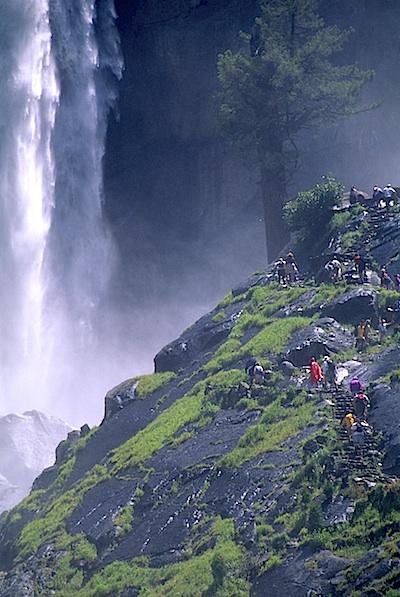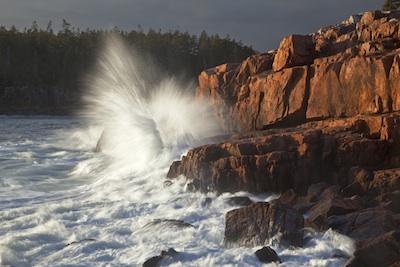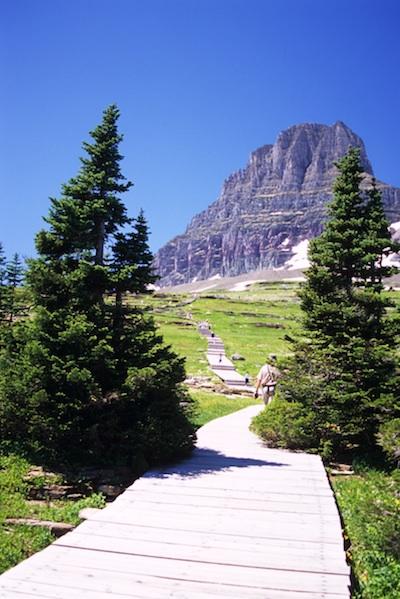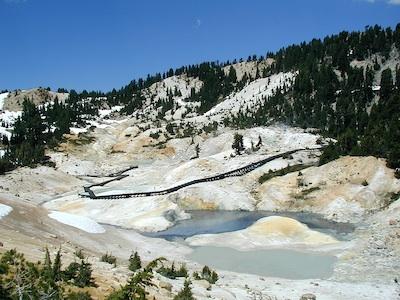
On a hot summer day, the Mist Trail at Yosemite National Park is wonderfully refreshing/Patrick Cone
Summer can pose a difficult problem for national park travelers: Where do you go and what should you do?
You could head to a national seashore or national lakeshore to cool off. Or visit the Rocky Mountains and dip your toes in Iceberg Lake at Glacier National Park in Montana.
Perhaps you should visit Nevada and Great Basin National Park's Baker Creek as it crashes down from 13,000-foot Wheeler Peak. June, July, and August are the months for high-country hikes, whether that high country is along the Teton Crest Trail of Grand Teton National Park in Wyoming or on the forested shoulders of Cadillac Mountain in Acadia National Park in Maine.
Mount Rainier National Park's high country in Washington state is a cool spot (relatively) in July and August, Voyageurs National Park in Minnesota offers watery miles of backcountry to paddle, and Wrangell-St. Elias National Park and Preserve in Alaska is tempting with its 13.2 million acres to wander, whether you do it on foot or in a raft. Wherever you wind up, take a hike.
Traveler's Facebook audience had some great ideas for family hikes in the parks, and we're happy to share them with you.
Just remember, individual capabilities range greatly, and while some hikes might be appropriate for your youngsters, peers in their age group might have difficulties. Bottom line: Judge your children's ability with safety in mind. And go prepared with plenty of water, wide-brimmed hats, sunscreen, snacks and, if you're heading into bear country, bear spray.
Now, let's take a look at some hikes!
Acadia's beautiful Carriage Roads offer a tranquil pedal or stroll through the shade of the park's hardwood forests. They're a favorite of Donna Fisher Wilhelm. There are water, trees, and mountains on the South Bubble Trail, which Jeff Klugh calls 'A moderate hike with a nice payoff at the top! We still can't push Bubble Rock over the edge!'
Youngsters can handle the 1.2-mile loop of the Ship Harbor Trail. 'A nice hike from woodland to the sea,' says Marty Grieger.

The family friendly Ship Harbor Trail at Acadia has some great views/Colleen Miniuk-Sperry
For more options, check out the park's hiking page.
The 3-mile roundtrip to Delicate Arch can be challenging to just about everyone on a hot summer day. Though it's only 1.5 miles one way, the trail marches up across sundrenched slickrock, rounds a corner on a somewhat narrow ledge, and then rewards you with a spectacular view of this iconic arch.
Plenty of water for all involved is mandatory. While Pam Nunno favored this hike in Arches, Amie Warth recommended you take your family to Devils Garden with its many trails. You can hike just 1.6 miles roundtrip on a mostly flat trail to Landscape Arch, or get more of a workout by following the nearly 6-mile-long Primitive Loop trail that will appeal to teens.
Summertime hiking in Big Bend can be rigorous, though Inga McFadden recommends the South Rim Trail with its views of Emory Peak. It does lead you up into higher elevations with its 2,000-foot gain, pulling you to cooler temps. At 12-14.5 miles roundtrip, this is best for families with lots of hiking miles under their boots.
Canyonlands National Park, Utah
This red-rock park offers a number of great family trails. A favorite of visitors is Mesa Arch in the Island in the Sky District. It's short (just a half-mile out and back) and the sunrise will burn an indelible image in your mind as the sun's rays peak through the arch. That said, youngsters are more apt to prefer clambering atop nearby Whale Rock.
Cuyahoga Valley National Park, Ohio
Often overlooked due to its Ohio location, Cuyahoga Valley offers some wonderful hiking options. Toni Stutler recommends the Ledges Trail, which is just about 2 miles (perfect for novice hikers), offers an overlook, and winds through hemlock and yellow birch forests.
Glacier National Park, Montana
One of the most popular, family friendly trails in Glacier is the Hidden Lake Trail, which Pam Winegar Pappas and Marc Poutre both rightly suggest. From Logan Pass it rewards you with wildflower-covered meadows, mountain goats, and the gorgeous lake far down below.

Mountain goats, and occasionally bighorn sheep, are seen along the Hidden Lake Trail at Glacier Natinoal Park/Kurt Repanshek
The nearby Highline Trail is another great one, notes Cynthia Schwartz, saying, 'It's a great place to take some incredible pictures.'
Also receiving votes in Glacier from Haze Mac and Ted Jacobi was the Avalanche Creek Trail, while the nearby Trail of the Cedars is favored by Cindy Shaffer. Both lead you through a bit of temperate rain forests, though the Avalanche Creek Trail is four miles long (vs. 0.7 miles) and the payoff is a gorgeous, towering basin where cataracts plunge into Avalanche Lake.
Grand Canyon National Park, Arizona
Many trail miles can be logged at the Grand Canyon, and not all are youngster friendly. The South Kaibab Trail, recommended by Elena Talladen, is for experienced hikers. A long day can be spent hiking down the trail to Phantom Ranch, enjoying lunch there, and working your way back to the South Rim. Though doing such a hike in one day, particularly during the summer, is frowned upon by park staff. That said, novice hikers will enjoy the 3-mile roundtrip down this trail to Cedar Ridge, where you'll find gorgeous views and restrooms.
Jeannette Brummett suggests the section of the South Rim's Rim Trail between Monument Creek Vista and Hermits Rest that is also known as the Hermit Road Greenway Trail. This is roughly 3 relatively level miles one way (you can ride the shuttle bus back to Grand Canyon Village), with some breathtaking views into the canyon.
Grand Teton National Park, Wyoming
Grand Teton is a Western icon for hikers, though some of the hikes are certainly more strenuous and challenging than others. Reaching the Teton Crest Trail, for instance, requires a 4,000-foot climb (via Death Canyon) out of the Jackson Hole Valley. But once you reach this trail, you can cruise 30+ miles through high-country grandeur, as Bobbie Tumolo recommends.
For a less strenuous, more reasonable, hike with youngsters, Chrissy Hughes suggests the Jenny Lake area, where you can hike to Hidden Falls or Inspiration Point, or simply stroll around this small lake nestled at the foot of the Tetons.
Great Smoky Mountains National Park, Tennessee-North Carolina
With 800 miles of hiking trails, Great Smoky Mountains offers many possibilities for family hikes. Rosie Bert Butterfield and Carrie Kobb suggest the Laurel Falls Trail with its 80-foot waterfall, while Leslie Linowski recommends the short hike through the woods to Rainbow Falls.
'We really enjoyed Boogerman Trail in Great Smoky,' says Soon Hee Green. 'It was quiet and untouched compared to many popular trails and the sight of old trees combined with rhododendrons and birds was perfect. It was fun hiking and reading about history of that trail how it was preserved by one man.' (Traveler footnote: Several bridges along the Boogerman Trail are out, and the park has no scheduled plans to repair them)
Another popular hike is the 8-mile roundtrip to Charlies Bunion, as recommended by Mike Waalkes. The Appalachian Trail is your path to a spectacular overlook. You gain 1,640 feet in elevation, making this hike perhaps not the best choice for young hikers.
Joshua Tree National Park, California
This desert park offers a setting in sharp contrast to those in the Rockies or High Sierra: a Joshua Tree-studded landscape that is inviting and curious. While summer might be too hot to do much hiking here, when cooler months arrive consider the nature hike to Barker Dam, a suggestion made by Lisa Dubois Hull.
Kenai Fjords National Park, Alaska
It seems few of us manage to reach Alaska, but if you make it to Kenai Fjords National Park, Chad Cameron Jones recommends heading to the Harding Ice Field and Exit Glacier to stretch your legs and enjoy the views.

Bumpass Hell is at Lassen Volcanic National Park, not Yellowstone/NPS
Lassen Volcanic National Park, California The views along the Bumpass Hell Trail are reminiscent of Yellowstone National Park, with its steaming thermal vents. At just 3 miles roundtrip, and with a gentle elevation drop, this trail is great for families, says Staci Danko.
Mount Rainier National Park, Washington
Such a big park, with so many hiking options! Elena Talladen recommends the Nisqually Vista Trail at Paradise, a 1.2-mile route that offers views of the Nisqually Glacier. Another Paradise trail worth exploring, says Randy Wilson, is the Skyline Trail. This 5.5-mile loop offers great wildflower displays in summer, as well as views of the Nisqually Glacier and, of course, Mount Rainier.
Redwood National and State Park, California
Roy Deering suggests the Mill Creek Trail found within Jedediah Smith Redwoods State Park. Spend a half-day wandering through old-growth redwoods and admire the crystalline waters of Mill Creek. Look closely and you might spy some of the coho and Chinook salmon that swim here.
Rocky Mountain National Park, Colorado
At Rocky Mountain, it's easy to get overwhelmed with hiking possibilities. Teri Egts recommends Chasm Lake for a nice family outing. It's a 8.5 miles roundtrip, with an elevation gain of 2,360 feet, so youngsters should be experienced hikers to tackle this one. But the payoff is the face of Longs Peak in your face!
For novice hikers, the half-mile path around Bear Lake is great, notes Mary Ledwin Rudd, who also says the Glacier Gorge area offers good walks. 'As your kids grow, you take them farther,' she says.
Shenandoah National Park, Virginia
The Limberlost Trail at Milepost 43 on the Skyline Drive is 'good for young kids and is also an accessible trail,' notes Kathy Haines. 'Story of the Forest Trail is good for kids, also.'
Nancy Davis Merrey agrees: 'It was the perfect place to take kids! That was the first place our girls saw caddis flies.'
Linda Long Turner, meanwhile, recommends 'any section of the Appalachian Trail' in the park, while Riley Hays would point you towards Dark Hollow Falls.
Yellowstone National Park, Wyoming/Montana/Idaho
Yellowstone has a lot of possibilities when it comes to hiking. While any of the boardwalks that wind through the geyser basins are perfect for families, there are other options to consider. If you head into the backcountry, don't forget your bear spray.
Katherine Linnemanstons recommends the 8-mile roundtrip Osprey Falls Trail a bit south of Mammoth Hot Springs. This trail switchbacks you to the bottom (and back up) of Sheepeater Canyon, where you stand before a 150-foot waterfall created by the Gardner River. Not necessarily a good hike for youngsters due to the steep descent and returning climb.
If you find yourself near Tower Junction, Todd Jasina suggests you try the Hellroaring Creek Trail. This 4-mile roundtrip is short compared to the Osprey Falls Trail, but involves a steep, roughly 500-foot descent down to the Yellowstone River. The payoff of this out-and-back hike is standing on the suspension bridge and gazing into Hellroaring Creek.
A relatively level hike leads 2.5 miles to Fairy Falls, which Betty Martin Bartelt recommends. You can build on that by continuing on to Imperial Geyser another half-mile or so down the trail.
Other family favorites include Uncle Tom's Trail with its great view of the Lower Falls in the Grand Canyon of the Yellowstone, recommended by Amy Waalen Hansen, and Mystic Falls, suggested by Garnett Johnson Hutchinson.
Yosemite National Park, California
Yosemite can present some difficult challenges if you're starting on the floor of Yosemite Valley, because most hikes head ...up! But if you study the park map carefully, you can find some great options.
Randy Arellano suggests the Sentinel Dome Trail, which heads off from the Glacier Point Road. The hike is an enjoyable 2.2 miles and takes you past wildflower colored meadows and forests and a 360-degree panoramic payoff.
Anthony Byrd and several others suggested the Clouds Rest Trail. The trailhead is on the west end of Tenaya Lake along the Tioga Road, and the trail runs 7 miles one-way, which can turn into a long day for younger hikers.
The Panorama Trail, recommended by Kathy Barkus, runs 8.5 miles from atop Glacier Point down to the Yosemite Valley floor. Naturally, you have some killer views along the way. But it's also steep in places, and younger hikers might wear out before the bottom. If your kids are experienced, this can be a great day-long hike past some incredible waterfalls (Illouette, Nevada, and Vernal) with outstanding views. (A bus ride from the valley floor will get you to the trailhead)
This red-rock cathedral offers a nice selection of hikes in Zion Canyon, and many more on the plateau above. Where do you start?
The 2-mile-long Kayenta Trail, suggested by Cassidy Allen, 'is not too taxing or long, but wonderful views and not too high to climb.' There are some drop-offs, though, but the payoff is the cool waters of the Emerald Pools.
A number of our Facebook followers recommended Angels Landing, though that hike might be a bit extreme for families with youngsters. For those hikers comfortable with precipitous trails, exposure, and having to rely on chains to reach the landing, this 5.4-mile hike packs a great reward with its panoramic view of Zion Canyon.
Another suggestion for a hike in Zion, from Wes Bridges, was the Narrows, though it again might be too challenging for 'tweens and younger.
That's just a broad sampling of the hiking possibilities in the National Park System. They are never-ending.



Comments
Some of the best trails at Mt. Rainier start at Sunrise, rather than Paradise, and are much less crowded in summer. The Sourdough Ridge trail leads to terrific views, while the trail back around "behind" Sunrise, to Shadow Lake and the backpacker campground not only is a great 3-mile loop with spectacular wildflowers in season (Paradise has fantastic wildflowers, of course, but you see different species and different distributions at Sunrise), but Mt. Rainier almost looks like it's looming out over you.
A relatively little-known (and snow-free except for the occasional lowland storm in winter) part of the park is in the northwest corner at Carbon River, where there's a beautiful example of a rare inland temperate rain forest with a sweet little nature trail. You can also hike up the ex-road (closed permanently to motor traffic due to flooding) to Ipsut Creek campground, with several side trails along the way leading to waterfalls and other interesting sights.
In Yellowstone, I spend most of my time on the boardwalks waiting for things to erupt [g], but the Artist Paint Pot trail is a good one, too, and so is the nature trail on the Blacktail Mountain Plateau (on the main road between Mammoth and Tower just west of the western entrance to the Blacktail Mountain Plateau road).
Little discussed, but magical in my view, is the Hoh Rainforest. You can take it from a short little educational trails close to a mile each, all the way to hitting the back country of the greater Olympic National Park. By accident, we arrived at the ranger station with extra portions of cake that were shared around with the rangers, and everyone enjoyed the visit.
Taking a child all the way to Angels Landing at Zion could lead to a charge of involuntary manslaughter. A much safer route is to take the Mesa Trail to Observation Point and back. Round trip is about 6 miles and the elevation change each way is about 900 ft. Also, you will be looking down at and past Angels Landing with a much more expansive view of Zion Canyon.
I would never do Angels Landing unless I was the only person on the cable part. There are places where the trail is 24-36 inches wide and hikers have to scoot around each other when going the opposite way with a 1,000 drop should someone slip and take you with them or inadvertantly cough, sneeze, or move their rear end and send you tumbling.